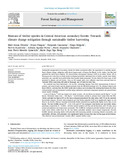Biomass of timber species in Central American secondary forests: Towards climate change mitigation through sustainable timber harvesting
Date
06-2021Auteur
Souza Oliveira, Maïri
Finegan, Bryan
Casanoves, Fernando
Delgado, Diego
Sepulveda, Norvin
Aguilar Porras, Adriana
Chamorro, María Alejandra
Morales Aymerich, Jean Pierre
Ngo Bieng, Marie Ange
Type
Artículo
Metadata
Afficher la notice complèteRésumé
Sustainable management of secondary forests for timber production offers the opportunity to combine nature-based climate change mitigation with direct improvement of human livelihoods in the tropics, but this dual potential has rarely been explored. We characterized aboveground biomass (AGB) in secondary forests (SF) in Nicaragua and Costa Rica in whole stands (ecological potential), individual trees of timber species (total timber potential), and currently harvestable timber (harvestable timber potential). We also linked the three types of AGB potential to climate and soil factors. Data on 302 sample plots were collected, most from national forest inventories (NFIs) concerning 168 plots in Nicaragua and 134 plots in Costa Rica. We analyzed data from individuals ≥20 cm dbh, estimating biomass from field measurements of stem diameters, and wood density and tree height estimates from the BIOMASS package in R. We obtained climate data from CHELSA, soil data from the ISRIC world soils database and determined the relationship between the three AGB potentials and environmental variables using exploratory principal components analysis and general linear mixed models (GLMMs). A mean 51 Mg ha 1 AGB was found to be stored in trees ≥20 cm dbh in dry forests and 68 Mg ha 1 in wet forests. Maximum values were > 250 Mg ha 1 in both biomes, similar to primary forest values from the NFIs. Timber potential was high at 84% of the mean ecological potential of the study plots, with 73% in the currently harvestable category.
Keywords
Éditeur
Elsevier, Ámsterdam (Países Bajos)


